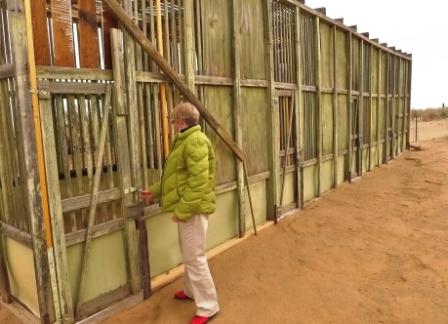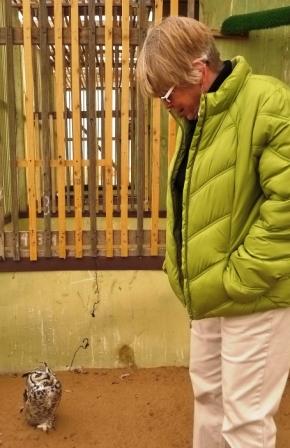
Injured Big Birds Find
a Safe Perch in Corrales
'Raptor Lady' passes keys to
new avian hotelier
It’s hard enough to save baby birds that have gotten injured or lost, as many well-meaning rescuers discover. Special knowledge is needed—along with a shoebox, blanket, and heat lamp—to keep the bird alive longer than an hour or two. When the victim is a large bird of prey, a shoebox is not going to do. And a correspondingly larger degree of knowledge is needed, in the form of federal and state permits that have been granted to only a couple hundred people nationwide.
Bird rescuer Mikal Deese inherited a large enclosure from "raptor lady" Shirley Kendall
that has allowed her to become an independent rehabilitator of large birds of prey.
Corrales bird rescuer Mikal Deese is now one of those few. She continues a tradition started by “the raptor lady,” Shirley Kendall, a New Mexico pioneer in wildlife rescue who also lives in Corrales. Kendall passed a very large torch to Deese in January in the form of a raptor enclosure, or mews. This amounts to a very large shoebox.
In fact, it’s the size of a boxcar. Happily, it was built in sections, so it stacks flat. “They offered it to me,” Deese says of Kendall and her husband Jack, who built the mews about a decade ago. “I thought, where can I find space for a 40-foot enclosure?
“After one day I said, I’ll find a place.” The acquisition allowed a new level of commitment for Deese, who has been caring for injured and baby birds for about a decade—a passion that led her to abandon a long career as a fine jeweler (“Trading Jewels in the Hand for Two in the Bush,” July/August 2011). Once the structure was installed in her yard, Deese was able to begin the arduous pursuit of government permits—a long series of exams, inspections, recommendations, and paperwork.
As of March, she is now an independent rehabilitator who no longer needs to work under the umbrella of a group such as Wildlife Rescue Inc., where she was trained. She is incorporating as a new nonprofit organization, On a Wing and a Prayer, and can accept any injured bird from the public, as well as make educational presentations with non-releasable hawks, eagles, crows, and other raptors.
“I love doing it,” she says of her new gig bringing designated “education birds” to classrooms, Boy Scout meetings, and birthday parties, where they calmly perch on her wrist on a leash. “There’s nothing like showing this big bird to a bunch of kids,” she grins. Her hope is that inspiring awe in children will lead to adults who respect wildlife, instead of using it for target practice.

On the sandy slope below her home, the green wooden enclosure looms above Loma Larga, offering no hint of the residents convalescing inside. They include on this chilly spring morning two Redtail Hawks and a Great Horned Owl, all with wings that don’t work. The hawks were brought by other rehabilitators, one found in a chicken house and the other hit by a car. The younger male “may be a little nutty,” Deese confides as he flaps frantically around the enclosure.
The point of keeping birds in these large cages is so they can practice flying before being released. A strip of metal along the sides of the dividable “rooms” prevents mice from scrambling up through the bars, so birds can also practice catching live prey. It may sound gruesome, but birds cannot be released until they can hunt.
The U.S. Fish and Wildlife Service actually owns all federally protected birds, releasable or not, and mandates how they are to be handled. Education birds each come with their own federal permits, and are often traded among rehabilitators for demonstration purposes.
The Great Horned Owl living in one part of the mews is a good example. She has been visiting classrooms for years, yet she scoots away nervously when approached. Wild birds never develop affection for humans, and should not be treated as pets. Their beauty is in their wildness, Deese says. That’s why rehabilitators steer clear of trying to “bond” with animals or impact their natural way of life any more than humans already have.
The enclosure and permits exist to make sure it stays that way.
Contact Mikal Deese at mikaldeese@aol.com or 505-897-0439.
